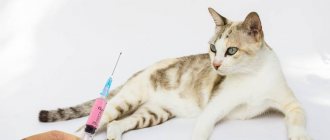Mycoplasmas are a blood parasitic infection. Mycoplasmas infect erythrocytes - red blood cells, which as a result leads to serious disruptions in the functioning of the immune system.
A cat owner must know how dangerous mycoplasma is, what negative effects can be expected for the body, and how to protect their pet from the development of pathology. Providing timely assistance to a cat with mycoplasmosis will help maintain the pet’s health and avoid the development of dangerous complications.
Description of the causative agent of mycoplasmosis
An infectious disease, of the contagious type, provokes changes in the functioning of various body systems. Mycoplasmosis leads to problems in the urinary and respiratory systems, provokes the development of conjunctivitis and inflammatory processes in the joints.
In some cases, a cat may be a carrier of mycoplasma, but will not show symptoms of the disease. In this regard, the diagnosis of mycoplasmosis is significantly complicated.
Blood cell problems are often associated with mycoplasmosis in cats. Pets are diagnosed with hemolytic anemia of the autoimmune type. Microscopic parasitic organisms actively infect red blood cells, causing a specific response from the immune system. As a result, this leads to the fact that the body's own protective cells perceive red blood cells as foreign and begin to attack them.
In veterinary medicine, only three types of mycoplasmas have been studied, most often diagnosed in domestic animals:
- M. haemofelis
- M. haemominutum
- M. turicensis
Mycoplasma haemofelis is the largest of the above-mentioned blood-parasitic microorganisms and in the vast majority of cases causes pathological processes in the body of domestic cats. The risk group for the development of mycoplasmosis includes cats with weak immune defenses - young and elderly animals, as well as those that are under stress or have suffered serious illnesses.
The connection between the development of mycoplasmosis in cats with the presence of viral immunodeficiency and viral leukemia in cats has also been proven. The true route of transmission of mycoplasmosis could not be identified, but the cat flea is believed to be a potential link.
Mycoplasmosis can be transmitted from a sick animal to a healthy one through close contact (for example, sexual intercourse or a fight). Fights with relatives, accompanied by serious bites until they bleed, scratches and other injuries.
Presumably, mycoplasmosis can be transmitted to infected cats that are bearing offspring. When passing through the birth canal, babies become infected with mycoplasmosis and may even die, since their immune system is weakened.
Mycoplasmosis: causative agent and course of the disease
Mycoplasmas (a separate type of protozoan) that cause disease in cats are called gatae and felis. A person is more often infected with the hominis strain, but other varieties are also dangerous for him.
Mycoplasmas that have entered the cat’s body actively produce toxins and infect red blood cells. Mycoplasma gatae leads to inflammation of the upper respiratory tract, and mycoplasma felis leads to disruption of the functioning of all internal organs and systems. The genitourinary and skeletal systems are particularly affected.
The main feature of these microorganisms is the absence of cell walls. They can easily change their appearance, complicating diagnosis. Mycoplasmas are also very resistant to some antibiotics, which complicates treatment with most popular drugs. Outside the body, they die under the influence of UV rays, low temperatures and chlorine disinfectants.
How does a cat become infected with mycoplasmosis?
The main ways of infecting a pet with mycoplasmosis are:
- airborne;
- straight on contact;
- sexual;
- from mother to kittens (when babies pass through the birth canal).
Mycoplasmas are able to reproduce under favorable environmental conditions. Parasitic microorganisms grow at temperatures from 18 to 42 degrees. The optimal temperature indicators for the growth of pathogens in the body of animals or humans are from 37 to 38 degrees. In this regard, the cat’s body is a favorable capsule for the development of mycoplasma.
At room temperature, microorganisms can remain active for 90 days, but when the temperature rises to 60 degrees, viability remains for about 10 minutes. When the surface is treated with ultraviolet light or when exposed to direct sunlight, mycoplasmas die after 3 hours.
The peculiarity of mycoplasmas is that they are not bacteria in the standard sense of this meaning. In this regard, mycoplasmas have a certain resistance to the effects of most antibiotics. Sulfonamides are also useless against mycoplasmas.
Mycoplasmas die when their shell is exposed to disinfectants and furan compounds.
Complications after illness
With timely detection of the disease and correctly prescribed treatment, complications are not observed. This is not so easy to do, because diagnosis is often difficult.
In protracted forms of mycoplasmosis, the consequences of the disease are more pronounced and are represented mainly by:
- Minor disturbances in the functioning of the cardiovascular system (arrhythmias - tachycardia and bradycardia, cardiac effusion, rarely - pericarditis).
- Chronic arthritis and arthrosis.
- Diseases of the liver (hepatitis, hepatosis), stomach (ulcers, gastritis), general disorders of the gastrointestinal tract (frequent constipation, diarrhea, less often - nausea and vomiting).
- Kidney diseases, nephrosclerosis (renal failure).
Danger of infection for humans
There is a danger of infection for humans, especially for those categories that have a weakened immune system. This includes small children under 3 years old, as well as:
- people with immunodeficiency virus;
- patients with chronic pathologies;
- those forced to undergo chemotherapy, as well as those who have recently undergone surgery.
It is worth noting that the likelihood of contracting mycoplasmosis directly from a domestic cat is much less than the strain that affects humans. But for the purpose of prevention, veterinarians recommend not to interfere or have close contact with domestic cats that have been diagnosed with mycoplasmosis. It is also not advisable to hand feed a sick animal until it has fully recovered.
In order to prevent infection with mycoplasmosis, it is necessary to thoroughly and regularly wash your hands with soap and treat with antiseptic agents.
Prevention of mycoplasmosis
There is no vaccine against mycoplasmosis, so prevention comes down to taking precautions, timely vaccination against other diseases, regular treatment for parasites, and a balanced diet.
Vaccination should be done against infections that may be complicated by mycoplasmosis (herpesvirus, calicivirus, chlamydia). Avoid stress and hypothermia. Do not let your pet out onto the street or balcony in cold weather, after bathing, avoid drafts, and if necessary, carefully insulate the carrier when transporting it.
Do not allow your pet to come into contact with potentially sick animals. If you have a new pet, you need to keep it in quarantine (in a separate room) for 14 days. If symptoms of the disease appear, you should consult a doctor and begin treatment, and after contact with a sick pet, thoroughly sterilize your hands and care items before contacting other cats.
Errors in the diet can provoke the development of conjunctivitis, rhinitis against the background of allergies, which will affect the growth of the mycoplasma colony. In addition, a lack of certain nutrients can negatively affect a pet’s immunity, so proper feeding is perhaps one of the most important aspects of preventing any disease.
Symptoms of mycoplasmosis in cats
Depending on what type of mycoplasma the domestic cat has, the state of immunity and the age of the animal, the symptoms will vary. The main signs of mycoplasmosis in cats are:
- Inflammation of the conjunctival membrane. Mycoplasmosis is most often characterized by hyperemia of the mucous membranes of the eyes and specific discharge. Damage to the corneal layer is less commonly diagnosed.
- Inflammatory processes in the respiratory tract. An animal with mycoplasmosis may suffer from a severe cough, discharge from the nasal passages, and fever. The disease can become chronic.
- Infectious lesions of the urinary and reproductive systems. Penetrating into the genital tract and urinary tract, mycoplasmas provoke the development of inflammation in the bladder, urethra, as well as endometritis and vaginitis. Characteristic signs of infection caused by mycoplasmosis are pain during urination, the inability to bear kittens, and discharge from the area of the cat's prepuce or loop. It is also possible for kittens to become infected inside the womb and for non-viable babies to be born.
- Diseases of internal organs. Animals with a weakened immune system are unable to resist mycoplasmosis. Pathogens enter the bloodstream through the mucous membranes, provoking inflammatory processes in the structures of the liver, kidneys, spleen and lungs.
- Infectious lesions of skeletal muscles. Inflammation occurs in the joints. Often with mycoplasmosis, polyarthritis develops, up to the appearance of lameness, feverish states, stiffness in movements, and general malaise. Multiple abscesses are diagnosed.
An asymptomatic course of mycoplasmosis is also possible. In such cases, the animal is a carrier of the infection, infecting animals near it through close contact.
Does a sick cat pose a danger to humans?
It is difficult to say whether mycoplasmosis in cats poses a danger to humans. There are two opinions on this matter. Some argue that the pathogens that cause disease in animals are not dangerous to humans.
Others say that when exposed to certain factors, contact with a sick cat can lead to serious consequences.
Particularly at risk are people with reduced immunity, those suffering from viral and infectious diseases, as well as children aged 0 to 3 years.
For women
In women, mycoplasmosis can lead to:
- menstrual irregularities;
- exacerbation of chronic pathologies of the reproductive organs;
- visual impairment;
- joint diseases;
- disruption of the liver and kidneys.
For men
For men with weakened immune systems, mycoplasmosis is dangerous:
- violation of potency;
- development of diseases of the genitourinary system;
- infertility.
Diagnosis of mycoplasmosis
The insidiousness of mycoplasmosis lies in the fact that pathogens are sometimes part of the normal opportunistic microflora. During normal functioning of the immune system, pathogens do not show their activity. As soon as the protective forces are reduced, mycoplasmas begin to actively develop, causing a number of pathological changes.
Making an accurate diagnosis is not possible without visiting a veterinarian. During an examination by a specialist, a number of laboratory tests are carried out, which must be carried out for an accurate diagnosis. It is recommended to:
- biochemical blood test;
- general blood test and for the presence of specific antibodies;
- general urine analysis.
Diagnostics includes a number of advanced techniques in the event that mycoplasmosis is in an advanced stage and has led to damage to internal organs. Thus, if inflammation of the genital organs and urinary tract by mycoplasmas is suspected, tests of specific prostate secretions are prescribed. For polyarthritis, synovial fluid samples are taken. In case of damage to the pulmonary structures, a study is performed - bronchoalveolar lavage.
Overt or hidden symptoms
The incubation period is about 10 days. All this time, mycoplasmosis does not manifest itself in any way. The first alarming changes are noted in the animal’s behavior. It becomes lethargic and drowsy, and may also refuse to eat. Gradually, other symptoms reminiscent of a common cold appear:
- sneezing and coughing;
- increased tearfulness and hypersalivation;
- redness and inflammation of the eyes;
- nausea and stool upset;
- increase in body temperature.
When diagnosed at this stage, the disease can be treated fairly quickly.
In other cases, the prognosis is ambiguous. It all depends on the degree of damage to the internal organs. With the loss of their functionality, the existing symptoms are supplemented by more pronounced signs:
- purulent discharge from the eyes;
- hair loss;
- pale gums;
- inflammation of the lymph nodes;
- urinary disturbance;
- joint pain;
- lameness;
- skin ulceration.
Most of the time, a sick pet just lies there. When trying to stand up, he clenches his paws or falls, since the standing position is given to him with great difficulty. All internal systems gradually fail, so at an advanced stage the animal dies from complications.
Treatment of mycoplasmosis in cats
Based on the tests obtained, the veterinarian can formulate the main stages of treatment. In-depth diagnostics may also include blood tests to identify other possible pathogens, since mycoplasmosis often occurs against the background of another disease. Treatment of mycoplasmosis in cats is not simple, as it is necessary to select an individual regimen. The following complexes are used:
- antibiotics – Doxycyline, Tetracycline;
- general strengthening drugs - Gamavit, Katazal;
- immunomodulatory agents – Transfer Factor and Immunofan;
- hepatoprotectors – Karsil;
- anti-inflammatory drugs - Dexavet.
Eye wash preparations based on medicinal plants and disinfectant solutions are also prescribed.
Diagnosis and treatment
If an animal has signs of mycoplasmosis, it must be taken to a veterinarian immediately. After reviewing the history, the doctor will perform a physical examination of the cat and order a complete blood test.
Pneumonia is a common complication after mycoplasmosis.
If an infection actually develops in the pet’s body, laboratory tests reveal anemia - a low level of red blood cells.
Along with this analysis, it is also recommended to do:
- screening;
- flow cytometry analysis (considered the most informative method for diagnosing mycoplasmosis);
- analysis of the genital mucosa;
- smear of the eye shell.
If the diagnosis is confirmed during the diagnosis, treatment of mycoplasmosis in cats is carried out immediately. There is no specific treatment regimen for this disease. It all depends on the severity of clinical manifestations and the general condition of the animal.
Antibacterial therapy is prescribed in any case. It suppresses bacterial growth and improves the pet’s well-being.
The choice of antibiotics is made individually after a special susceptibility test. If the pet is found to have severe anemia, a blood transfusion is performed.
Be sure to read:
What is dangerous about toxoplasmosis, symptoms and treatment of the disease in cats and people
In addition to antibacterial therapy, symptomatic treatment is also carried out, which includes taking astringent, analgesic and antiemetic drugs.
Quite often, the only sign of mycoplasmosis in cats is weakness of the animal.
Also during this period it will be useful for the animal to take medications and dietary supplements that help improve the functioning of the digestive system.
To speed up the recovery process and prevent the development of complications due to mycoplasmosis, it is recommended to give the animal immunomodulatory drugs.
Important! If mycoplasmosis in cats manifests itself with severe symptoms, then treatment is carried out in a hospital.
Only after the pet’s condition returns to normal is it given back to its owners, but the therapy does not end there. At home, you will also need to ensure that the animal takes all necessary medications, proper nutrition and rest.
Medicines
All medications for the treatment of mycoplasma in an animal, their dosage regimen, dosage and duration are determined by the doctor individually. However, there are some medications that are used in almost 90% of cases.
Doxycycline and chloramphenicol are broad-spectrum antibiotics that are highly effective in combating pathogens of mycoplasmosis.
Veterinarians prescribe azithromycin to support pet immunity
Positive results from taking them are observed already on the second day. If an animal shows intolerance to these drugs, then they are replaced with Tylosin or Baytril.
For this disease, the following are also often prescribed:
- Karsil, Katozal or Gamavit - these products stimulate the functioning of internal organs.
- Cycloferon, Immunofan or Ribotan - the action of these drugs is aimed at strengthening the immune system.
- Tetracycline has an antibacterial effect and is used to treat affected mucous membranes of the eyes and genitals.
Caring for a cat when sick
To prevent the development of complications due to mycoplasmosis in a cat and treatment to produce quick results, the animal must be provided with proper care.
All medications for the treatment of mycoplasma in an animal, their dosage regimen, dosage and duration are determined individually by the doctor.
If there are no other pets in the apartment, there is no need to isolate him. It’s enough just to create a comfortable and convenient lounger for him.
To avoid causing unnecessary suffering to the cat, you should not pick it up. This is due to the fact that with the development of mycoplasmosis, all joint and bone tissues of the animal are affected, and any movements can cause severe pain.
Important! Bathing, combing and walking your pet during the treatment period is prohibited.
Diet for the duration of treatment
At the time of treatment, the cat's diet should be adjusted. If she is fed at home, you need to make sure that the food she eats is fresh and prepared from high-quality products.
Be sure to read:
What is dangerous about toxoplasmosis, symptoms and treatment of the disease in cats and people
It is important to provide the animal with plenty of fluids, vitamins and minerals. To replenish the latter, you can use special vitamin complexes for pets. When choosing them, you must take into account the age and weight of the cat.
What to feed a cat diagnosed with mycoplasmosis
The nutrition of an animal suffering from mycoplasmosis must be rational. If your pet is used to receiving natural food, it is recommended to consult a veterinarian about vitamin and mineral supplements to the diet. Food should be easily digestible, but at the same time replenish all the body’s energy reserves.
It is best to give your pet canned food and ready-made granulated food used for liver pathologies during treatment of mycoplasmosis and for the first time after complete recovery.
The food should also be hypoallergenic, since the processes occurring in the body during mycoplasmosis negatively affect the immune system. Treatment of mycoplasmosis is long-term – from 3 weeks to several months (in the chronic form of the pathology). Therefore, the owner’s task is to create all the conditions for successful treatment.
Diagnostics
The diagnosis of mycoplasmosis is made based on symptoms and laboratory tests. Samples from affected organs are used for research. In this case, it is important that the smear is taken directly from the walls of the mucous membranes, using a special probe, capturing epithelial cells. This is necessary because the pathogen multiplies in epithelial cells and to confirm the diagnosis it is necessary to detect it there, and not on the surface in secretions, where mycoplasma can also be found in healthy animals.
The samples taken are sent to the laboratory in a special tube with a transport medium for examination by PCR or bacteriological culture.
Can a cat that has had mycoplasmosis get it again?
This possibility exists. This can also happen due to violations of the content rules. Mycoplasmas can be found on surfaces and animal care items. Therefore, when treating a cat for diagnosed mycoplasmosis, it is very important to isolate the pet from other animals. Also important:
- Keep the room clean by regularly changing the bedding on which the cat sleeps.
- Provide free access to clean drinking water. If the cat is so weakened that it cannot rise on its own, it is necessary to give the pet water from a syringe without a needle or from a pipette.
- Limit contact with human hands. The point here is not only about the risk of infection of the owner himself. A sick animal may suffer from discomfort and pain, so at the time of treatment, it is better to limit lifting the animal in your arms.
- Observe any changes in the animal's condition. The slightest deterioration in health requires immediate contact with a veterinary hospital.
Prevention
Unfortunately, at present there is no vaccine for kittens that could protect them from this unpleasant disease. To prevent your pet from getting sick, you need to adhere to simple preventive measures, such as a balanced diet, no contact with stray animals, the use of individual household items, maintaining immunity through annual medical examinations and timely vaccination.
Preventive measures and attentive attitude on the part of the owner will help to avoid infection of kittens, which will delight with their beauty, health and activity.











